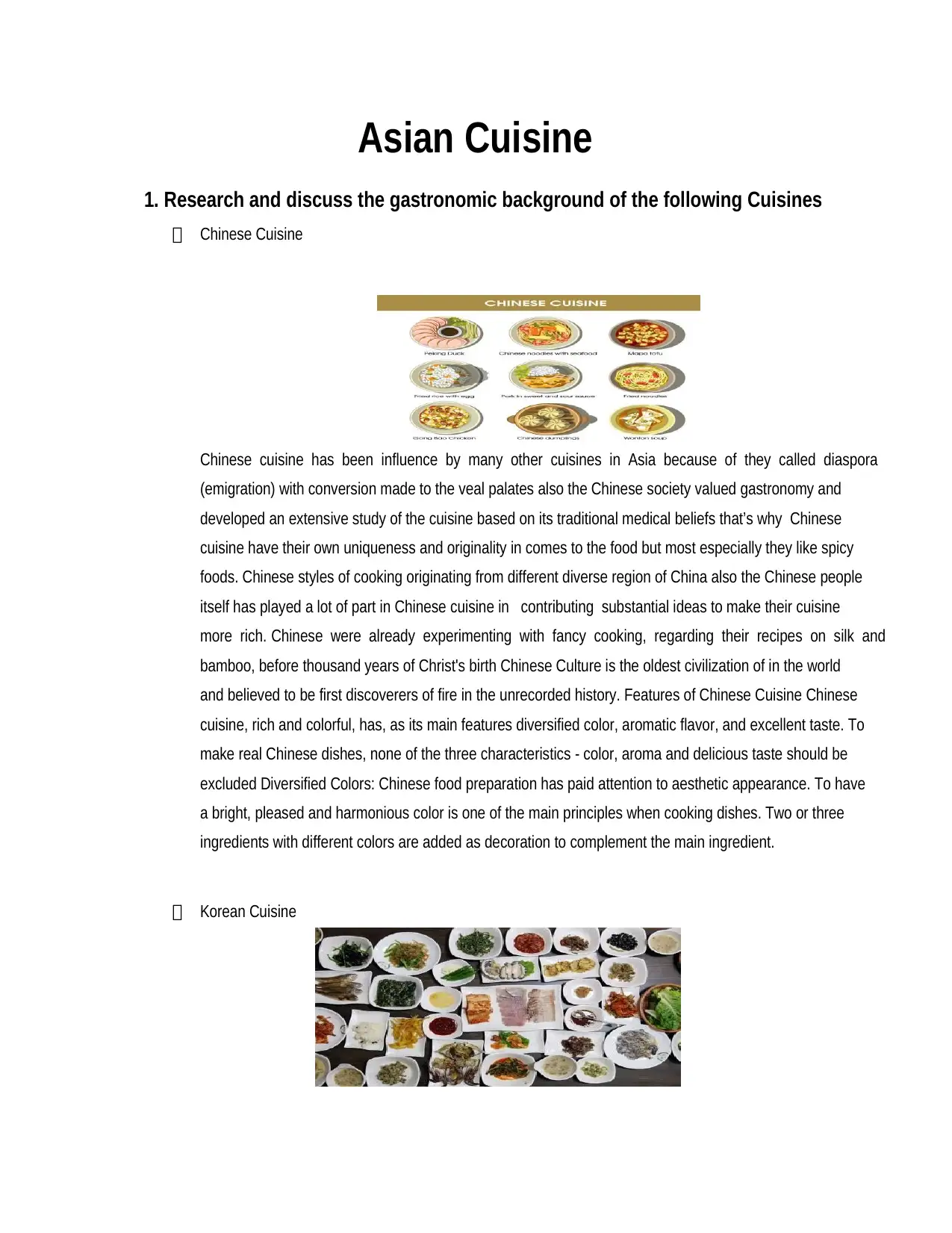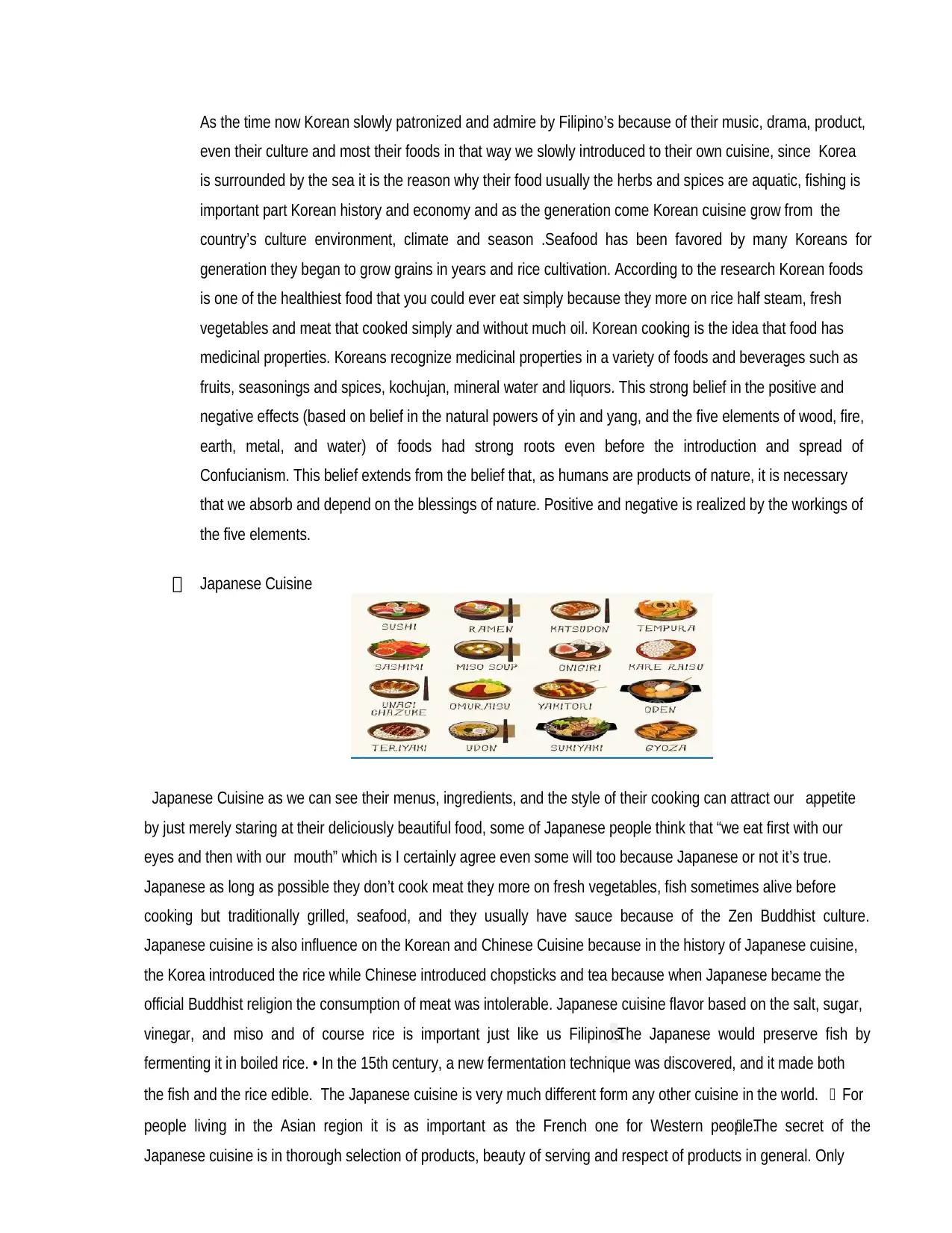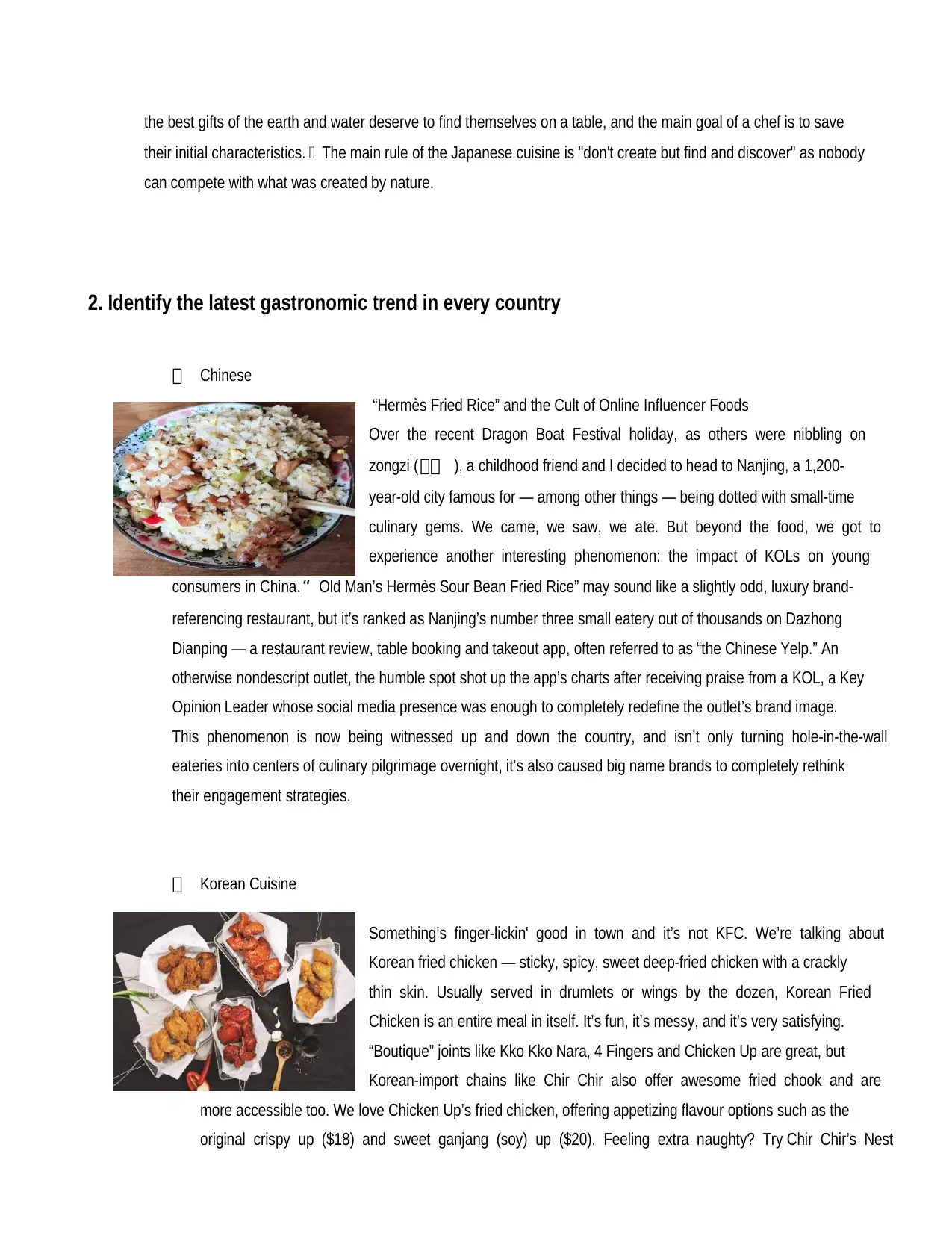A Comprehensive Report on Asian Cuisine: Background and Latest Trends
VerifiedAdded on 2021/11/19
|5
|1553
|204
Report
AI Summary
This report provides a detailed analysis of the gastronomic backgrounds and current trends in Chinese, Korean, and Japanese cuisines. It begins by exploring the unique characteristics and influences of each cuisine, including the historical and cultural factors that have shaped them. The report then delves into the specific features of Chinese cuisine, such as its diversified colors, aromatic flavors, and excellent taste, as well as the influence of regional variations. The Korean cuisine section highlights the importance of seafood, rice cultivation, and the belief in the medicinal properties of food. The Japanese cuisine section explores the emphasis on fresh ingredients, the influence of Zen Buddhist culture, and the importance of presentation. Finally, the report identifies the latest gastronomic trends in each country, including the popularity of "Hermès Fried Rice" in China, Korean fried chicken, and the evolving popularity of Gyoza in Japan.

Asian Cuisine
1. Research and discuss the gastronomic background of the following Cuisines
Chinese Cuisine
Chinese cuisine has been influence by many other cuisines in Asia because of they called diaspora
(emigration) with conversion made to the veal palates also the Chinese society valued gastronomy and
developed an extensive study of the cuisine based on its traditional medical beliefs that’s why Chinese
cuisine have their own uniqueness and originality in comes to the food but most especially they like spicy
foods. Chinese styles of cooking originating from different diverse region of China also the Chinese people
itself has played a lot of part in Chinese cuisine in contributing substantial ideas to make their cuisine
more rich. Chinese were already experimenting with fancy cooking, regarding their recipes on silk and
bamboo, before thousand years of Christ's birth Chinese Culture is the oldest civilization of in the world
and believed to be first discoverers of fire in the unrecorded history. Features of Chinese Cuisine Chinese
cuisine, rich and colorful, has, as its main features diversified color, aromatic flavor, and excellent taste. To
make real Chinese dishes, none of the three characteristics - color, aroma and delicious taste should be
excluded Diversified Colors: Chinese food preparation has paid attention to aesthetic appearance. To have
a bright, pleased and harmonious color is one of the main principles when cooking dishes. Two or three
ingredients with different colors are added as decoration to complement the main ingredient.
Korean Cuisine
1. Research and discuss the gastronomic background of the following Cuisines
Chinese Cuisine
Chinese cuisine has been influence by many other cuisines in Asia because of they called diaspora
(emigration) with conversion made to the veal palates also the Chinese society valued gastronomy and
developed an extensive study of the cuisine based on its traditional medical beliefs that’s why Chinese
cuisine have their own uniqueness and originality in comes to the food but most especially they like spicy
foods. Chinese styles of cooking originating from different diverse region of China also the Chinese people
itself has played a lot of part in Chinese cuisine in contributing substantial ideas to make their cuisine
more rich. Chinese were already experimenting with fancy cooking, regarding their recipes on silk and
bamboo, before thousand years of Christ's birth Chinese Culture is the oldest civilization of in the world
and believed to be first discoverers of fire in the unrecorded history. Features of Chinese Cuisine Chinese
cuisine, rich and colorful, has, as its main features diversified color, aromatic flavor, and excellent taste. To
make real Chinese dishes, none of the three characteristics - color, aroma and delicious taste should be
excluded Diversified Colors: Chinese food preparation has paid attention to aesthetic appearance. To have
a bright, pleased and harmonious color is one of the main principles when cooking dishes. Two or three
ingredients with different colors are added as decoration to complement the main ingredient.
Korean Cuisine
Paraphrase This Document
Need a fresh take? Get an instant paraphrase of this document with our AI Paraphraser

As the time now Korean slowly patronized and admire by Filipino’s because of their music, drama, product,
even their culture and most their foods in that way we slowly introduced to their own cuisine, since Korea
is surrounded by the sea it is the reason why their food usually the herbs and spices are aquatic, fishing is
important part Korean history and economy and as the generation come Korean cuisine grow from the
country’s culture environment, climate and season .Seafood has been favored by many Koreans for
generation they began to grow grains in years and rice cultivation. According to the research Korean foods
is one of the healthiest food that you could ever eat simply because they more on rice half steam, fresh
vegetables and meat that cooked simply and without much oil. Korean cooking is the idea that food has
medicinal properties. Koreans recognize medicinal properties in a variety of foods and beverages such as
fruits, seasonings and spices, kochujan, mineral water and liquors. This strong belief in the positive and
negative effects (based on belief in the natural powers of yin and yang, and the five elements of wood, fire,
earth, metal, and water) of foods had strong roots even before the introduction and spread of
Confucianism. This belief extends from the belief that, as humans are products of nature, it is necessary
that we absorb and depend on the blessings of nature. Positive and negative is realized by the workings of
the five elements.
Japanese Cuisine
Japanese Cuisine as we can see their menus, ingredients, and the style of their cooking can attract our appetite
by just merely staring at their deliciously beautiful food, some of Japanese people think that “we eat first with our
eyes and then with our mouth” which is I certainly agree even some will too because Japanese or not it’s true.
Japanese as long as possible they don’t cook meat they more on fresh vegetables, fish sometimes alive before
cooking but traditionally grilled, seafood, and they usually have sauce because of the Zen Buddhist culture.
Japanese cuisine is also influence on the Korean and Chinese Cuisine because in the history of Japanese cuisine,
the Korea introduced the rice while Chinese introduced chopsticks and tea because when Japanese became the
official Buddhist religion the consumption of meat was intolerable. Japanese cuisine flavor based on the salt, sugar,
vinegar, and miso and of course rice is important just like us Filipinos.The Japanese would preserve fish by
fermenting it in boiled rice. • In the 15th century, a new fermentation technique was discovered, and it made both
the fish and the rice edible. The Japanese cuisine is very much different form any other cuisine in the world. For
people living in the Asian region it is as important as the French one for Western people. The secret of the
Japanese cuisine is in thorough selection of products, beauty of serving and respect of products in general. Only
even their culture and most their foods in that way we slowly introduced to their own cuisine, since Korea
is surrounded by the sea it is the reason why their food usually the herbs and spices are aquatic, fishing is
important part Korean history and economy and as the generation come Korean cuisine grow from the
country’s culture environment, climate and season .Seafood has been favored by many Koreans for
generation they began to grow grains in years and rice cultivation. According to the research Korean foods
is one of the healthiest food that you could ever eat simply because they more on rice half steam, fresh
vegetables and meat that cooked simply and without much oil. Korean cooking is the idea that food has
medicinal properties. Koreans recognize medicinal properties in a variety of foods and beverages such as
fruits, seasonings and spices, kochujan, mineral water and liquors. This strong belief in the positive and
negative effects (based on belief in the natural powers of yin and yang, and the five elements of wood, fire,
earth, metal, and water) of foods had strong roots even before the introduction and spread of
Confucianism. This belief extends from the belief that, as humans are products of nature, it is necessary
that we absorb and depend on the blessings of nature. Positive and negative is realized by the workings of
the five elements.
Japanese Cuisine
Japanese Cuisine as we can see their menus, ingredients, and the style of their cooking can attract our appetite
by just merely staring at their deliciously beautiful food, some of Japanese people think that “we eat first with our
eyes and then with our mouth” which is I certainly agree even some will too because Japanese or not it’s true.
Japanese as long as possible they don’t cook meat they more on fresh vegetables, fish sometimes alive before
cooking but traditionally grilled, seafood, and they usually have sauce because of the Zen Buddhist culture.
Japanese cuisine is also influence on the Korean and Chinese Cuisine because in the history of Japanese cuisine,
the Korea introduced the rice while Chinese introduced chopsticks and tea because when Japanese became the
official Buddhist religion the consumption of meat was intolerable. Japanese cuisine flavor based on the salt, sugar,
vinegar, and miso and of course rice is important just like us Filipinos.The Japanese would preserve fish by
fermenting it in boiled rice. • In the 15th century, a new fermentation technique was discovered, and it made both
the fish and the rice edible. The Japanese cuisine is very much different form any other cuisine in the world. For
people living in the Asian region it is as important as the French one for Western people. The secret of the
Japanese cuisine is in thorough selection of products, beauty of serving and respect of products in general. Only

the best gifts of the earth and water deserve to find themselves on a table, and the main goal of a chef is to save
their initial characteristics. The main rule of the Japanese cuisine is "don't create but find and discover" as nobody
can compete with what was created by nature.
2. Identify the latest gastronomic trend in every country
Chinese
“Hermès Fried Rice” and the Cult of Online Influencer Foods
Over the recent Dragon Boat Festival holiday, as others were nibbling on
zongzi ( ), a childhood friend and I decided to head to Nanjing, a 1,200-
year-old city famous for — among other things — being dotted with small-time
culinary gems. We came, we saw, we ate. But beyond the food, we got to
experience another interesting phenomenon: the impact of KOLs on young
consumers in China.“ Old Man’s Hermès Sour Bean Fried Rice” may sound like a slightly odd, luxury brand-
referencing restaurant, but it’s ranked as Nanjing’s number three small eatery out of thousands on Dazhong
Dianping — a restaurant review, table booking and takeout app, often referred to as “the Chinese Yelp.” An
otherwise nondescript outlet, the humble spot shot up the app’s charts after receiving praise from a KOL, a Key
Opinion Leader whose social media presence was enough to completely redefine the outlet’s brand image.
This phenomenon is now being witnessed up and down the country, and isn’t only turning hole-in-the-wall
eateries into centers of culinary pilgrimage overnight, it’s also caused big name brands to completely rethink
their engagement strategies.
Korean Cuisine
Something’s finger-lickin' good in town and it’s not KFC. We’re talking about
Korean fried chicken — sticky, spicy, sweet deep-fried chicken with a crackly
thin skin. Usually served in drumlets or wings by the dozen, Korean Fried
Chicken is an entire meal in itself. It’s fun, it’s messy, and it’s very satisfying.
“Boutique” joints like Kko Kko Nara, 4 Fingers and Chicken Up are great, but
Korean-import chains like Chir Chir also offer awesome fried chook and are
more accessible too. We love Chicken Up’s fried chicken, offering appetizing flavour options such as the
original crispy up ($18) and sweet ganjang (soy) up ($20). Feeling extra naughty? Try Chir Chir’s Nest
their initial characteristics. The main rule of the Japanese cuisine is "don't create but find and discover" as nobody
can compete with what was created by nature.
2. Identify the latest gastronomic trend in every country
Chinese
“Hermès Fried Rice” and the Cult of Online Influencer Foods
Over the recent Dragon Boat Festival holiday, as others were nibbling on
zongzi ( ), a childhood friend and I decided to head to Nanjing, a 1,200-
year-old city famous for — among other things — being dotted with small-time
culinary gems. We came, we saw, we ate. But beyond the food, we got to
experience another interesting phenomenon: the impact of KOLs on young
consumers in China.“ Old Man’s Hermès Sour Bean Fried Rice” may sound like a slightly odd, luxury brand-
referencing restaurant, but it’s ranked as Nanjing’s number three small eatery out of thousands on Dazhong
Dianping — a restaurant review, table booking and takeout app, often referred to as “the Chinese Yelp.” An
otherwise nondescript outlet, the humble spot shot up the app’s charts after receiving praise from a KOL, a Key
Opinion Leader whose social media presence was enough to completely redefine the outlet’s brand image.
This phenomenon is now being witnessed up and down the country, and isn’t only turning hole-in-the-wall
eateries into centers of culinary pilgrimage overnight, it’s also caused big name brands to completely rethink
their engagement strategies.
Korean Cuisine
Something’s finger-lickin' good in town and it’s not KFC. We’re talking about
Korean fried chicken — sticky, spicy, sweet deep-fried chicken with a crackly
thin skin. Usually served in drumlets or wings by the dozen, Korean Fried
Chicken is an entire meal in itself. It’s fun, it’s messy, and it’s very satisfying.
“Boutique” joints like Kko Kko Nara, 4 Fingers and Chicken Up are great, but
Korean-import chains like Chir Chir also offer awesome fried chook and are
more accessible too. We love Chicken Up’s fried chicken, offering appetizing flavour options such as the
original crispy up ($18) and sweet ganjang (soy) up ($20). Feeling extra naughty? Try Chir Chir’s Nest
⊘ This is a preview!⊘
Do you want full access?
Subscribe today to unlock all pages.

Trusted by 1+ million students worldwide

Snow ($32.90), fried chicken tenders nestled in a savoury-sweet creamy white sauce and a corn salad,
topped with a huge dollop of fresh whipped cream. Best paired with the chain’s speciality Chir Cream Beer
($13.90), a tall glass of beer crowned with fluffy whipped cream. See you at the gym, folks.
Japanese Cuisine
Gyoza popularity has changed by 18.92% over the past year. On
average, Gyoza is consumed 1.51 times every year.Gyoza dumpling is one of
the most popular food not only in Japan but also the rest of the world. That’s all
set to change with the invention of “Happy Maru“, a range of colorful boiled gyoza
“dumplings” infused with beautifying collagen and polyphenols for the health and
beauty-conscious modern woman. But just what’s so different about them?
The new Happy Maru gyoza were developed by frozen foods company Osaka
Ohsho to cater “specifically to the needs and desires of women”. In fact, they’re the result of a series of
brainstorming sessions held by an all-female research and development team within the company. Happy
Maru has been designed to appeal to women in every way, from the inclusion of added beauty ingredients
right down to the color scheme and the cute packaging. We love getting extra health benefits from our
food, so we just had to know more about these wonder dumplings.
topped with a huge dollop of fresh whipped cream. Best paired with the chain’s speciality Chir Cream Beer
($13.90), a tall glass of beer crowned with fluffy whipped cream. See you at the gym, folks.
Japanese Cuisine
Gyoza popularity has changed by 18.92% over the past year. On
average, Gyoza is consumed 1.51 times every year.Gyoza dumpling is one of
the most popular food not only in Japan but also the rest of the world. That’s all
set to change with the invention of “Happy Maru“, a range of colorful boiled gyoza
“dumplings” infused with beautifying collagen and polyphenols for the health and
beauty-conscious modern woman. But just what’s so different about them?
The new Happy Maru gyoza were developed by frozen foods company Osaka
Ohsho to cater “specifically to the needs and desires of women”. In fact, they’re the result of a series of
brainstorming sessions held by an all-female research and development team within the company. Happy
Maru has been designed to appeal to women in every way, from the inclusion of added beauty ingredients
right down to the color scheme and the cute packaging. We love getting extra health benefits from our
food, so we just had to know more about these wonder dumplings.
Paraphrase This Document
Need a fresh take? Get an instant paraphrase of this document with our AI Paraphraser

1 out of 5
Related Documents
Your All-in-One AI-Powered Toolkit for Academic Success.
+13062052269
info@desklib.com
Available 24*7 on WhatsApp / Email
![[object Object]](/_next/static/media/star-bottom.7253800d.svg)
Unlock your academic potential
Copyright © 2020–2025 A2Z Services. All Rights Reserved. Developed and managed by ZUCOL.




